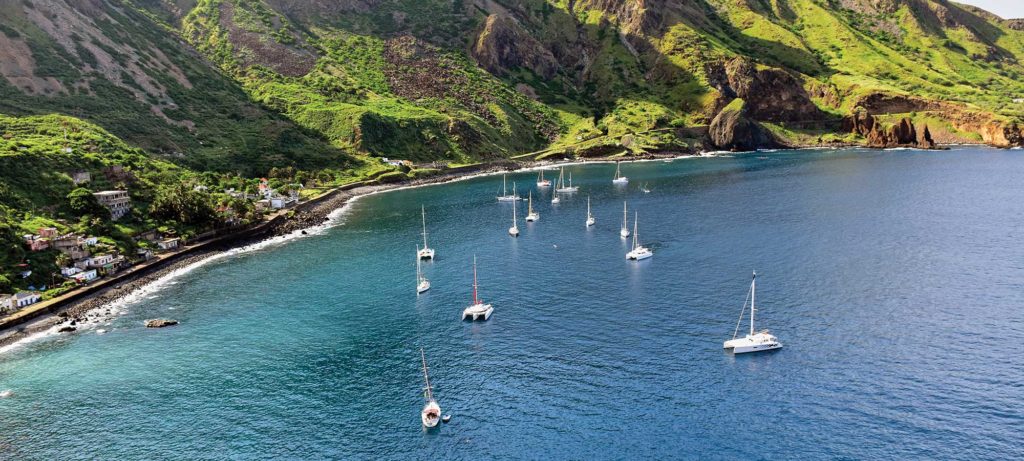
After spending three delightful seasons in the Mediterranean on La Mischief, our Lagoon 421 catamaran, I finally convinced my partner, DeAnne, to leave with the promise that we’d be back one day if we just kept going west. So we plotted our escape route from Cyprus through the Strait of Gibraltar and out into the Atlantic. Our planning got a huge boost when I discovered Jimmy Cornell‘s Barbados 50 Rally, which started from London and finished in Barbados just as celebrations were kicking off for the island’s 50th anniversary of independence, would be making the crossing at the same time. DeAnne and I signed up to join the rally in the Canary Islands, and we left Algeciras, Spain, with our friends Phil Hearps and Megan Wood on board. Along the way, we cruised the Moroccan coast to take in the delights of Casablanca, Marrakesh and Agadir before making the 225-nautical-mile passage to Lanzarote in the Canaries, where Megan said her goodbyes.
For the next four weeks, La Mischief sailed to all the Canary Islands, enjoyed the spectacular scenery and hospitality of the locals, and got to know the crews of the other 35 rally boats as well as Cornell and his staff. Then it was time to head south to the islands of Cabo Verde.
The 780-nautical-mile trip down from the Canaries to Mindelo, Cabo Verde, was both frustrating and exhilarating. Frustrating because of the amount of motoring we had to do, but with an exhilarating sail at the end once we hit the trades and spent two straight days under spinnaker.
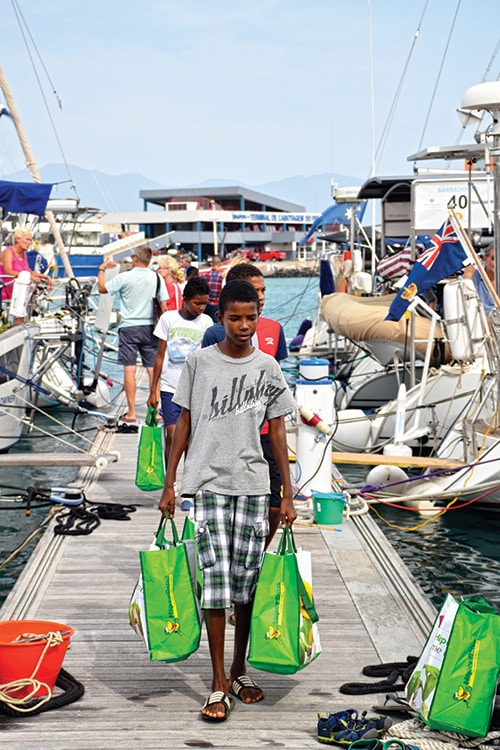
La Mischief reached Mindelo after five days and checked into Cabo Verde’s only marina, where we joined the other rally boats. Our two friends Sten Strom and Rita Matthews flew into Mindelo to accompany us on what was to be the first-ever organized cruising rally around Cabo Verde, before coming with us across the Atlantic to Barbados.
We instantly fell in love with Mindelo, on the island of São Vicente, with its vibrant and unique music scene, colorful buildings from colonial days past and its overwhelmingly happy and friendly people. A highlight was the welcome party put on by Marina Mindelo, where a drumming band met us on the piers and marched us down to a marquee complete with dancers, food, beer, wine and the local rum. I could have sworn that we were already in the Caribbean.
La Mischief‘s crew spent a delightful week in Mindelo, which included a fascinating tour of the island organized by the rally, swimming at the beautiful white-sand town beach and visits to quite a few of the excellent restaurants, each with live music playing. Toward the end of our stay at the marina, we stopped at the local fruit and vegetable markets, as well as the two or three supermarkets, where you could purchase enough to get by. I was, however, thankful that we had done most of our provisioning in the big supermarkets in the Canaries.
Lutz Meyer-Scheel, who is a co-owner of the marina, had been working hard with Cornell Sailing to put together our cruise of the islands. Because some of the anchorages and ports were too small for 35 boats, the rally split into two fleets. Meyer-Scheel’s local sailing knowledge was invaluable, and the night before Fleet 1 left, he gave us a useful skippers briefing on what we were all about to see and experience.
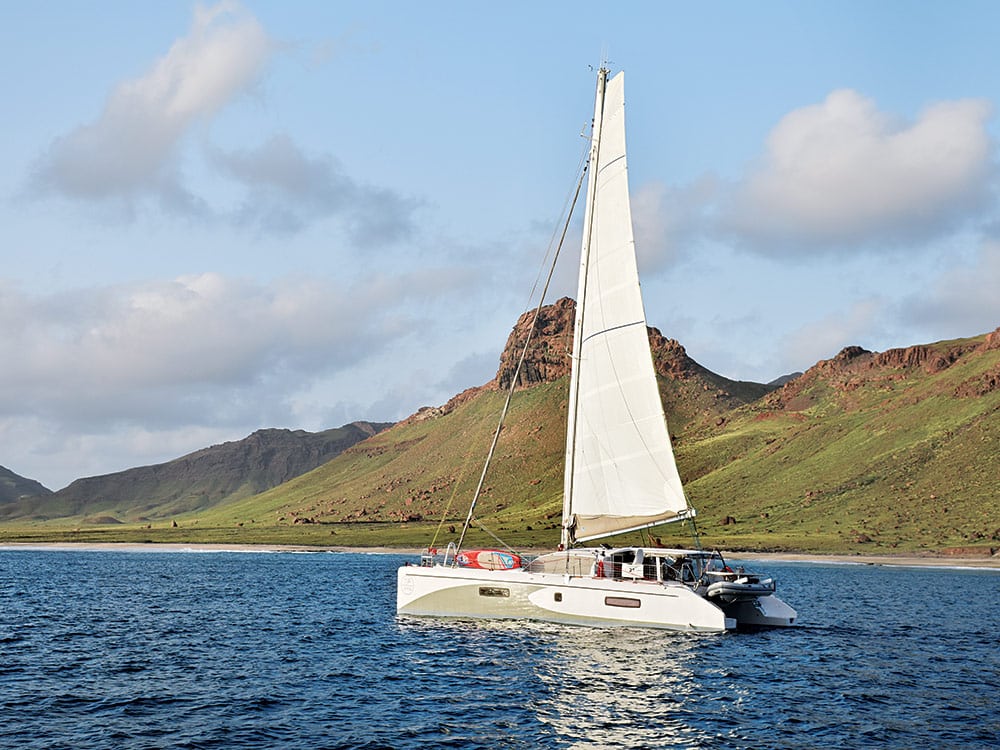
The anchorage was small but spectacular, with huge cliffs plummeting down to a large black-sand beach. The town of Tarrafal was a short dinghy ride away.
Our first stop was Tarrafal on the island of Santo Antão, 23 nautical miles away. La Mischief left the marina at about 1100 and had a great reach doing 7 knots until we got to the lee of Santo Antão, where the wind dropped to nothing. We motored around to the southwest corner and dropped anchor in about 50 feet of water. The anchorage was small but spectacular, with huge cliffs plummeting down to a large black-sand beach. The town of Tarrafal was a short dinghy ride away, albeit with an interesting surf landing that took us a while to perfect.
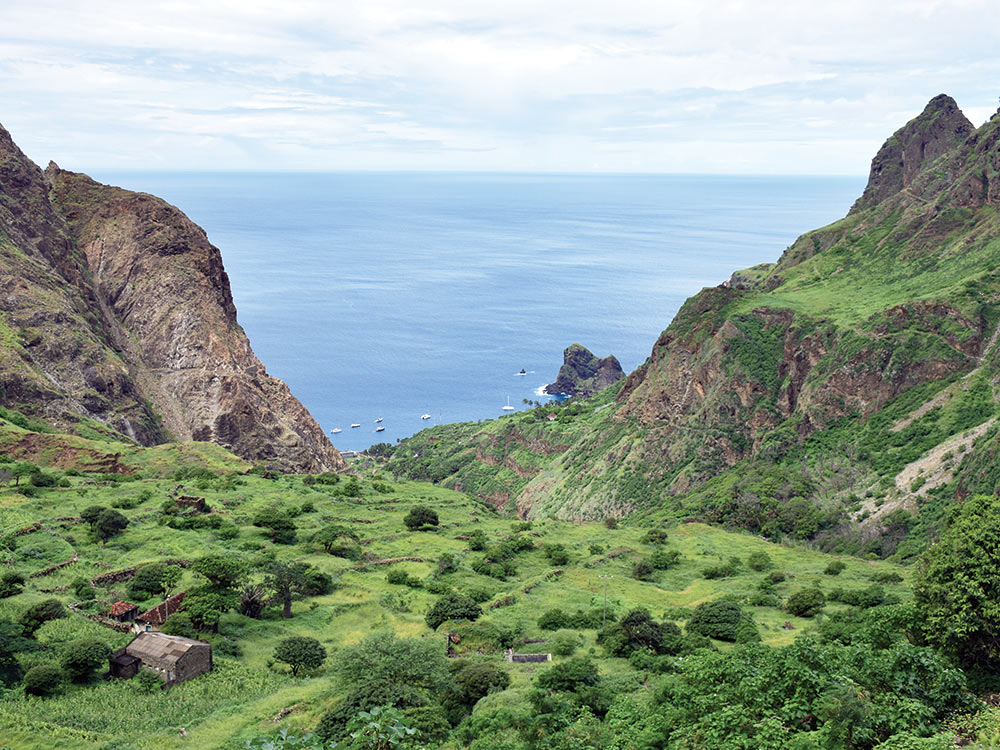
The next day, the crew relaxed and swam off the back of the boat, explored the town and its surroundings, and socialized with the other rally yachts. Several crews arranged a lobster dinner at the local restaurant, and it didn’t disappoint, with three huge lobster halves for each person, accompanied by plenty of fresh vegetables, all washed down with the local beer. Scrumptious! And Sten, Phil and I managed to launch off the beach that night without getting wet. Bonus.
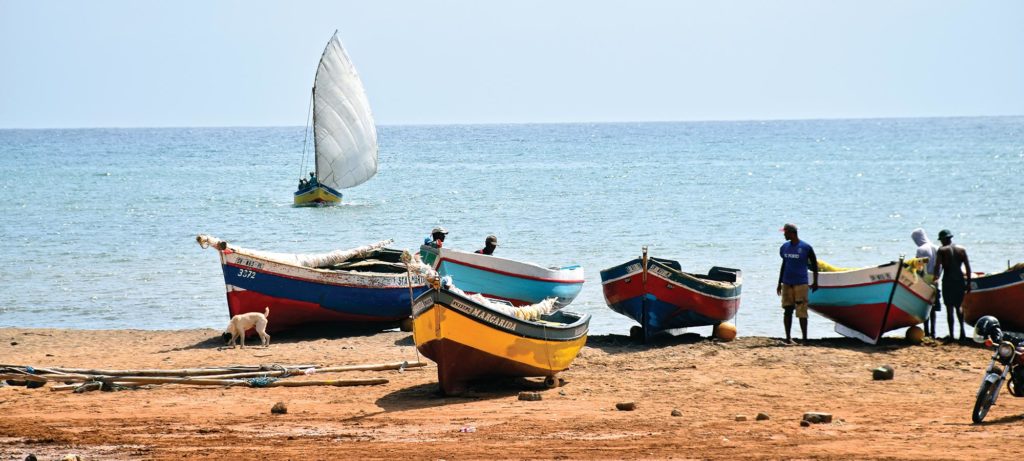
The next morning, we were up early and off to Brava, 120 nautical miles away. The fleet was looking forward to a downhill run, but that unfortunately didn’t materialize. The best La Mischief could do was to pull out the gennaker for a few hours. Since there were thunderstorms around, we put it away at dark and had a wonderful sail under main and jib right up to midnight, when the squalls hit and the wind turned southerly. The rest of the night was slow-going as we bashed into the wind and waves, using the radar to pick our way through the lightning storms.
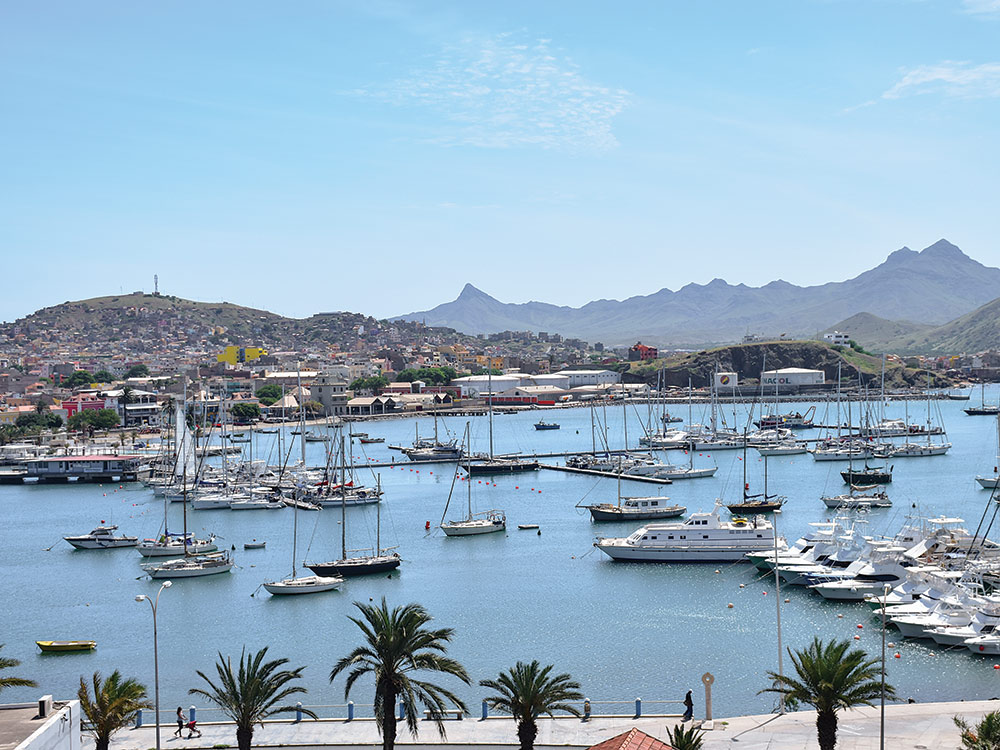
It was certainly worth the effort because the anchorage at Fajã d’Agua turned out to be one of our favorites. La Mischief finally arrived at 1100, and was greeted by a huge pod of dolphins as we lowered sails and motored into the harbor. We dropped the hook at the northern end of the very protected bay, where we found good holding in 30 to 50 feet of water. Some of the other yachts anchored in the southern part of the bay and had to contend with large boulders on the seabed.
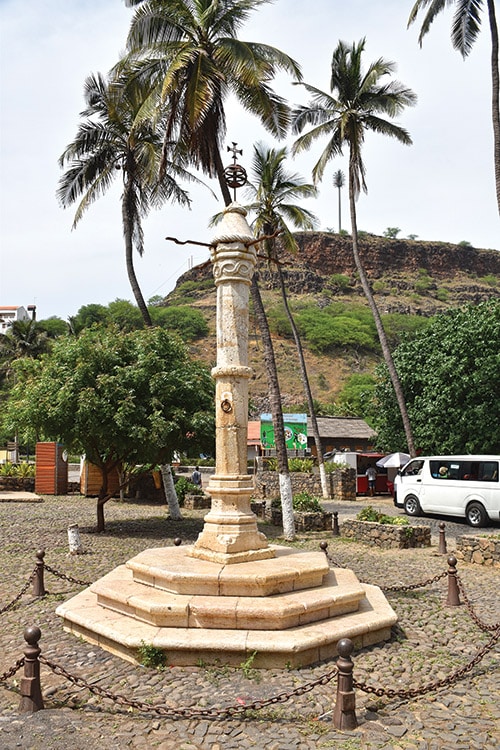
Luc Callebaut from Cornell Sailing was brilliant at organizing activities for us; on the first full day our fleet was on Brava, we put on our hiking shoes and followed a guide on a fantastic walk up the valley. Three hours later, after snapping many spectacular photos looking down the valley to the boats, our hiking group made it to a small village. There, we hopped on a bus to take us to the largest town on the island to do some shopping, before returning along a very interesting road cut into the cliffs. By then we were all very hungry, and we sat down for an enjoyable late lunch at Anna’s restaurant on the waterfront.
The next morning, several of us squeezed in a short island tour with Carlos, who drove us around and showed us life on the island together with some sensational scenery. It was really good to hang out with Carlos, who seemed to know every one of the 5,000 inhabitants on the island, many of whom spoke with U.S. East Coast accents, from having worked and lived there before returning home to Brava.
Back on La Mischief, we raised the sails and headed off to Fogo. There was a bit of tacking involved in getting around the top of Brava, but once clear of the island, we had a wonderfully fast 20-mile sail across to Fogo.
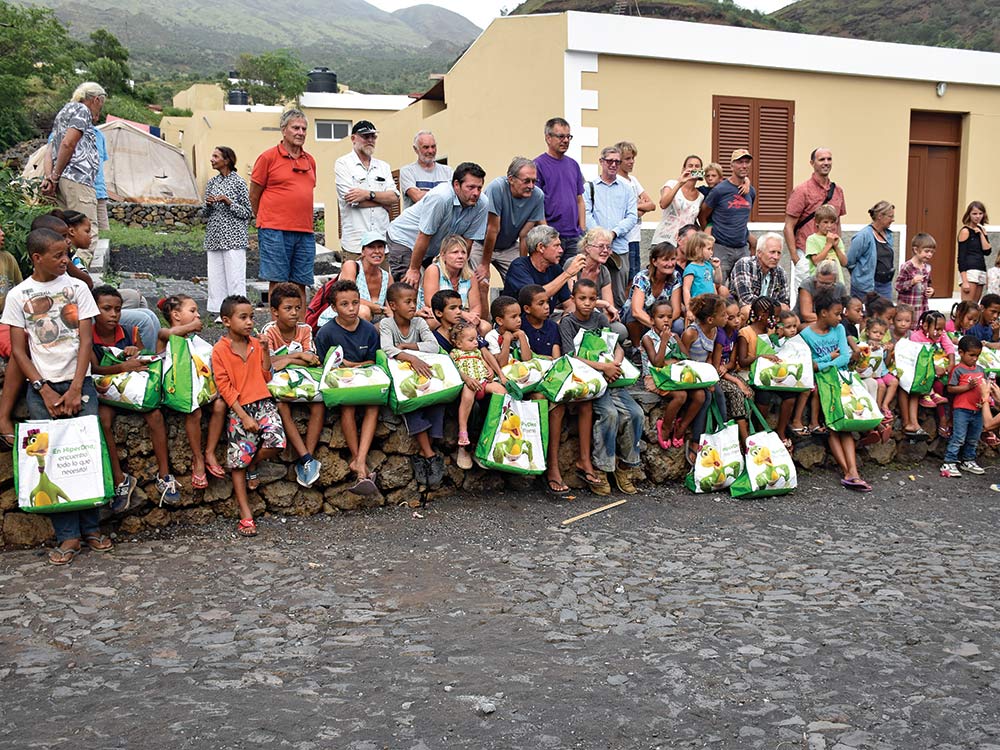
Fogo, which is Portuguese for fire, sports a single classic volcanic cone. At 9,281 feet high, Pico do Fogo is the second-tallest volcano in the Atlantic, after El Teide on the island of Tenerife.
The island of Fogo is fantastic. We went on a full-day island tour, the highlight of which was a visit to the crater at the top of the volcano.
Our rally had organized for us to tie up against the two harbor walls; we’d timed our arrival and departure to ensure no ships or ferries would be there. The harbor wall, with its large rubber bollards sticking out, was designed to accommodate ships, not yachts, and the fleet spent two uncomfortable nights there, resulting in lots of chafing and wrecked fenders.
Still, it was worth the hassle and sleepless nights because the island of Fogo is exceptional. The whole fleet went on a full-day island tour, the highlight of which was a visit to the crater at the top of the volcano. We had lunch at the winery inside the crater and sampled the famous Fogo wine and coffee, straight from the highest place on the planet where these two crops grow. After lunch, we visited one of the spots the caldera inhabitants were evacuated to after the last eruption, and the Barbados 50 Rally donated many bags of clothing, towels and toiletries to the children of the village.
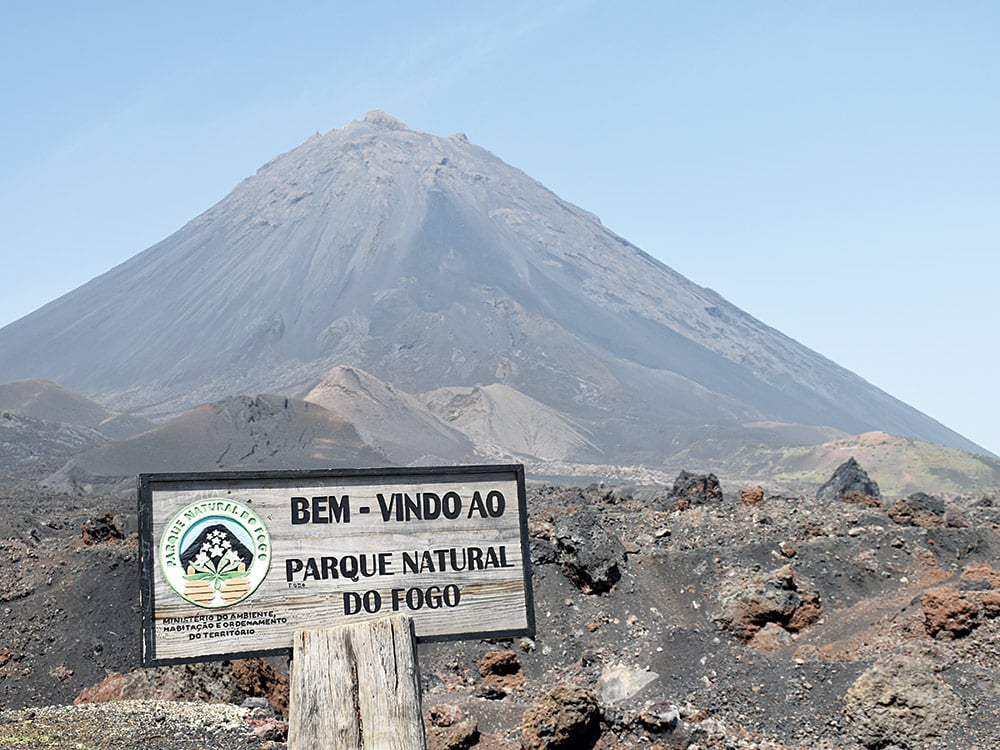
The next morning, the crews were up early and off to the island of Santiago, heading for yet another town named Tarrafal on the west coast of the island. This time, the wind gods were not on our side, and the 55-nautical-mile leg took us all day and a bit more, making our arrival just after nightfall. Rob from BnG, one of our fellow rally boats, kindly guided us into the anchorage, and we dropped the hook in about 50 feet. We spent the following day walking through Serra da Malagueta Natural Park, eating lunch at a beautiful beachside restaurant and checking out Praia, the capital of Cabo Verde, before returning back to our anchorage.
Our next leg was a night sail, so we spent the day leading up to it at Tarrafal, swimming off the back of La Mischief, as well as at the lovely town beach. Our crew stocked up on a few items at the local supermarket and the excellent produce market (and we might have even been spotted frequenting a local beach bar).
We were really looking forward to the next anchorage on the island of São Nicolau, 86 nautical miles away to the north. We left Tarrafal at 1700 and made good time on a tight reach — so much so that we deliberately slowed down the boat to make sure we reached our anchorage in daylight. As we rounded the bottom of São Nicolau, we were delighted to see pods of pilot whales all around us.
Meyer-Scheel had recommended that we anchor off a beautiful sandy beach, about a mile or so south of yet another town called Tarrafal, and it turned out to be a far nicer anchorage than the one at Tarrafal itself. It’s the nicest anchorage in São Nicolau — some say the nicest in the whole of Cabo Verde. And who am I to argue? It has a beautiful sandy bottom with great holding where you can clearly see your anchor in 15 to 25 feet of water, a delightful protected beach and great snorkeling. To top it off, there’s a nice hike into Tarrafal around a rough path.
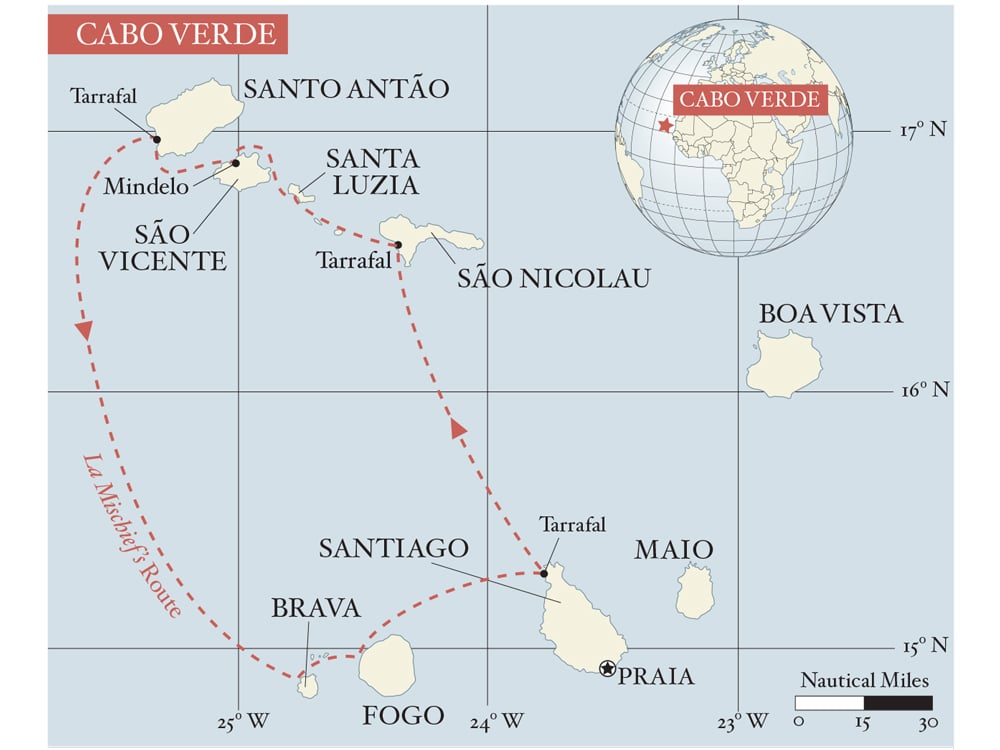
It was the rally’s last stop before returning to Mindelo, so many crews opted to spend a bit more time here on anchor rather than in the marina at Mindelo. However, the crew on La Mischief was enjoying cruising all the islands and wanted to do one more. We chose Santa Luzia, which was halfway back to Mindelo. We anchored there at Praia do Palmo a Tostão off a long white-sand beach in 22 feet of water, along with a couple of other rally boats. Later, we found out from the marina staff that the island is now a nature reserve and anchoring is prohibited, something our cruising guide failed to point out.
In no time at all, La Mischief was back in the marina at Mindelo, where we completed our final preparations for our 2,020-nautical-mile trip across the Atlantic to Barbados.








